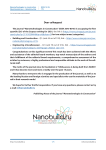Nanotechnologies in Construction: A Scientific Internet-Journal @nanobuild-en
Статьи журнала - Nanotechnologies in Construction: A Scientific Internet-Journal
Все статьи: 572
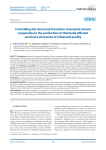
Статья научная
Introduction. Research to improve the quality of foam concrete products through targeted control of technological processes of structure formation of cement-based compositions is relevant. The strength of foam concrete is significantly influenced by the adhesion strength of the hardened cement paste to the aggregate. This article discusses methods of chemical and mechanochemical activation of foam concrete filler with glyoxal-containing additives, interaction with hydration products of binders and increasing the strength of the contact zone. The quality of foam concrete can be improved by controlling the properties of the contact zone. Materials and methods. The study was conducted using standard test procedures specified in national standards. Results. With preliminary chemical and mechano-chemical exposure of the sand surface to glyoxal-containing additives and its subsequent introduction into the foam concrete mixture the grade of strength of foam concrete increases to B1 while maintaining the average density grade D500 in comparison with foam concrete of the control composition, while the shrinkage value decreases by 20–38.5% and thermal conductivity coefficient by 37%. Conclusion. The use of glyoxal-based additives in foam concrete mixtures by pre-activating the sand surface can improve the quality of cement foam concrete.
Бесплатно
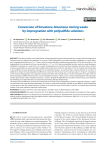
Conversion of limestone-limestone mining waste by impregnation with polysulfide solutions
Статья научная
The data of studies on the effectiveness of impregnating Aquastat waste generated as a result of the development of limestone-shell rock deposits are presented. As a result of sand impregnation, the water absorption coefficient as a result underwent a significant decrease from 7 to 17 times, while the water absorption coefficient decreases from 32.5% for the initial to 1.9% impregnated. Even treatment with low concentrated (ρ = 1.17 g / cm3) calcium polysulfide solution made the water absorption coefficient to decrease to a value of 4.5%. As a result of impregnation of crushed stone from limestone-limestone with a solution of calcium polysulfide, the water absorption coefficient decreases from 25.0% for untreated to 5.2% for treated, and the decrease in the coefficient of water absorption is greater for concentrated solutions. It was found that a solution density of 1.24 g/cm3 is sufficient to reduce the water absorption coefficient to a value of 5.2%, the same as for a density value of 1.35 g/cm3. Comparison of the results of impregnation with «Aquastat» solution and sulfur melt showed that as a result of treatment with sulfur melt, the water absorption coefficient decreases by 13.3 and strength increases by 2 times, and as a result of impregnation with «Aquastat» solution decreases by 4.62%, strength increases by 1.35 times. Despite the high efficiency of sulfur melt processing, such treatment has drawbacks associated with the use of autoclave technology and high temperatures. The results of the modification of sand and crushed stone from shell rock by impregnating it with the «Aquastat» solution, a significant decrease in the water absorption parameter, an increase in compressive strength, revealed the possibility of using impregnated crushed stone as the layer material lying at the base of the road structures of local roads in the form of crushed stone and sand instead of the more expensive imported crushed stone.
Бесплатно
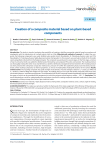
Creation of a composite material based on plant-based components. Nanotechnologies in construction
Статья научная
Introduction. The study is aimed at analyzing the possibility of creating a building composite material based on amylose and amylopectin with the introduction of crushed walnut shells as a filler. Materials and methods of research. To obtain the composite, the following components were used: distilled water, potato starch (NevaReaktiv, St. Petersburg, Russia), acetic acid 70% (NevaReaktiv, St. Petersburg, Russia), highly dispersed walnut shell powder. For this research, we used walnut shells of the Chandler variety (engrafted) collected form the Belgorod region. The composite was produced in several stages. At the first stage, a mixture of starch and walnut shells was added to distilled water, followed by a pre-prepared 9% acetic acid solution. The resulting mixture was thoroughly mixed, after which it was transferred to a stainless-steel bowl and subjected to heat treatment. The resulting mixture was then pressed with solid-phase compaction method at a pressure of 72 MPa. We studied the physical and mechanical characteristic of the resulting composite, its thermal properties, as well as the hydrophobic-hydrophilic balance of the surface. Results and discussion. The resulting composite has good strength characteristics. Flexural strength at break is σf = 25.85±2.51 MPa and σf = 28.44±5.71 MPa for filling 50% weight and 75% weight. Accordingly, they put it on a par with similar composites made from more conventional thermo- and thermoset polymers. The temperature limit for the composite material exploitation has been established, the upper of which can be considered the temperature at which the polymer matrix begins to soften – 103.1 °C. Conclusion. The results obtained are crucial for understanding the mechanisms involved in creating composite materials made entirely from plant components, utilizing, among other factors, agro-industrial waste.
Бесплатно
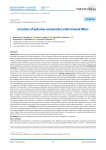
Creation of polymer composites with mineral fillers
Статья научная
Introduction. Currently, the development of science and technology requires the creation of new polymer composites with high technical characteristics for various industries. One of the primary methods to improve the physical and technical characteristics of polymer composites based on thermoplastic elastomers is by incorporation of natural fillers. In the Kyrgyz Republic, there is particular interest in using fine mineral fillers extracted from local natural resources. The minerals and rocks found in the region are characterized by high availability, extensive reserves, and a variety of properties. The accumulated experience in research and practical application opens up prospects for using these materials to create polymer composites with unique characteristics. This opens up new possibilities for using the cavitation process in various industrial applications, including the grinding of materials. Methods and materials. An experimental hydrocavitation mill has been developed to produce fine powders from minerals and rocks intended for use as fillers in polymer composites. The physicochemical properties of polymer composites and their raw materials were studied using modern instruments and equipment. The fractional composition and physical and technical characteristics of some minerals and rocks used to obtain active fillers for polymer composites are given. Results and Discussion. The fractional composition of crushed fillers with a particle size of less than 0.31 mm is distributed as follows: finely ground basalt – 7.3%, wollastonite – 44.6%, marble dust – 50.26%, brown coal powder – 47.56%. The analysis shows that among the studied fillers, finely ground basalt contains the smallest amount of fine fractions, which is due to its high hardness compared to other minerals such as wollastonite, marble, and coal. Physical and mechanical studies of the resulting polymer composites showed that when finely ground basalt is added, an uneven distribution of basalt powder in the polymer matrix is observed, which leads to a decrease in the strength characteristics of the composite. Therefore, to obtain a more durable material, it is necessary to grind minerals and rocks to the level of microparticles using the cavitation effect. For this purpose, a laboratory mill was created that operates based on the cavitation effect. Fillers at the level of micro- and nanoparticles were obtained using the developed hydro cavitation mill. The physical and technical characteristics of polymer composites with additives of the resulting nanofillers have been determined. The compressive strength of composites with mineral fillers (fraction less than 0.31 mm, content of wollastonite filler in the composite – 25.2%) was 5.47 MPa, with basalt filler – 5.2 MPa, and with leather powder (dust) – 4.25 MPa. Fillers at the level of micro- and nanoparticles were obtained using the developed hydro cavitation mill. The physical and technical characteristics of polymer composites with additives of the resulting nanofillers have been determined. The compressive strength of composites with mineral fillers (fraction less than 0.31 mm, content of wollastonite filler in the composite – 25.2%) was 5.47 MPa, with basalt filler – 5.2 MPa, and with leather powder (dust) – 4.25 MPa. The compressive strength of the composite with the addition of carbon filler (13.2%) was 4.2 MPa. The introduction of up to 14.2% of mineral fillers into the composition of the composite increases its heat resistance: when adding basalt filler – up to 106 °C, and wollastonite – up to 114 °C. Conclusion. The fractional composition of mineral fillers based on inorganic raw materials studied for their use in creating polymer composites. A hydro cavitation mill was made and a method for processing fillers from minerals and rocks was developed. New polymer composites were obtained with the addition of basalt, wollastonite, marble, and leather industry waste. Studies have been carried out on the physical and technical characteristics of these polymer composites depending on the content of fillers, such as basalt, wollastonite, marble and leather industry waste.
Бесплатно
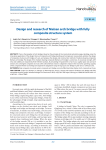
Design and research of Nielsen arch bridge with fully composite structure system
Статья научная
China is the kingdom of arch bridges. Based on the principle of structural elastic potential energy standing value, the innovative application of the design theory of composite arch bridge bending and compression is presented, optimize the design of composite structural arch bridge arch axis, and propose the design and construction method of medium-bearing composite Nielsen arch bridge. The design of the medium-bearing composite Nielsen arch bridge is carried out, its structural strength, stiffness and stability are analyzed by finite element analysis. By simulating the parameters of arch axis, sagittal span ratio and arch section, the convergent composite arch axis with solid web foot section is adopted to improve the economic spanning capacity of the composite Nielsen arch bridge and expand the adaptation range of large span arch bridge in plain area or soft base area.
Бесплатно

Destruction of stable emulsions using nanodispersed fullerenes
Статья научная
Introduction. This article describes the results of the destruction processes studies of stable emulsion suspension sludge systems, conducted by the authors. Destruction processes are achieved by adding nanoparticles to demulsifying compositions. Currently, there is no universal composition demulsifier that effectively destroys emulsions formed in oil sludges. Research methods. To deal with this issues, the authors have conducted research on the creation of an effective demulsifier containing nanosized particles of fullerenes. The studies were carried out with dispersed oil-slurry emulsion-suspension systems, selected from open storage ponds of enterprises of JSC «Tatoilgaz» and JSC «TAIF-NK». For the destruction of the oil-containing system of the emulsion-suspension type, a composite mixture of complex action has been developed, which includes anionic wetting agents, nonionic surfactants, flotation reagents, detergents and alkaline buffer solutions that provide the required value of a constant indicator of the acid-base balance of the aqueous medium. Results and its discussion. A composite demulsifying mixture of complex action, which increases the effectiveness of the wetting washing action of surfactants, namely, the diphilic structure of the dispersed medium changes to hydrophilic, that is, the contacts of particles having a monophilic surface with the hydrocarbon phase of the emulsion medium are broken. When particles pass into the water volume from the phase separation boundary, the layer on the surface of the emulsified water is destroyed. The dehydration time of petroleum products is reduced by almost 2 times. Conclusion. During the research, the intensification and increase of the efficiency have been successfully reached.
Бесплатно
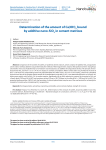
Determination of the amount of Ca(OH)2 bound by additive nano-SiO2 in cement matrices
Статья научная
Comparison of the content of Ca(OH)2 in hardened cement matrices, which contains the additive SiO2 nanoparticles and in matrice without additives was performed by the method of thermogravimetric analysis. Alite portland cement «SsangYong» and «Denki» were used. Hydrothermal sol of «Geosil» was introduced as an additive of nanoparticles of SiO2. The amount of introduced nano-SiO2 was from 1.15 to 1.74 wt.% in respect to cement consumption. Water-cement ratio was provided at the level of W/C = 0.39–0.26. The compensating amount of polycarboxylate SVC-5Neu was 0.2–0.77 wt. %. The Ca(OH)2 content was calculated from the mass loss of the cement matrice sample in the temperature range 460–510оC. It was determined that the sol «Geosil» additive reacts quickly with Ca(OH)2 (CH) in cement matrice, significantly (up to 40%) reducing its content. By the period of 24 h sol «Geosil» binds 750 [mg CaO /g SiO2] and continues to bind CH up to 100–700 days, to the value δCaO = 1300 [mg CaO /g SiO2]. The pozzolan binding reaction Ca(OH)2 with the formation of calcium hydrosilicates may be one of the mechanisms for increasing the strength of concrete when introducing SiO2 nanoparticles.
Бесплатно
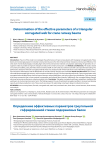
Determination of the effective parameters of a triangular corrugated web for crane runway beams
Статья научная
Introduction. The aim of this study is to investigate the performance of crane runway beams with triangular corrugated webs. These beams are increasingly popular in industrial construction because of to their enhanced shear resistance and structural efficiency. Flat webs have several disadvantages, including high stress levels and excessive material consumption. Optimizing the geometry of corrugations makes it possible to improve strength and reduce the overall construction cost. Methods and Materials. The study is based on numerical modeling using the finite element method (FEM) in LIRA-CAD 2022 software and full-scale experimental testing. The performance of beams with both corrugated and flat webs was analyzed under wheel loads from cranes with lifting capacities of 10, 30, and 50 tons. Deformations and the distribution of normal and shear stresses were evaluated. Results and Discussion. The numerical model demonstrated high accuracy, with a maximum deviation of only 2.9% from experimental results. Crane runway beams with corrugated webs exhibited lower shear and normal stresses, reduced deflections, and more uniform force distribution. They also proved to be more economical due to lower material consumption and reduced labor intensity. Additionally, the corrugated beams showed enhanced economic performance, reducing material costs. Conclusion. Triangular corrugated web beams outperform traditional flat web beams in structural and economic terms. The findings support the use of optimized corrugation profiles to increase load-bearing capacity and reduce production costs. These results are relevant for optimizing crane beam design in industrial structures.
Бесплатно
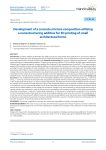
Статья научная
Introduction. Currently, additive technologies are widely used across various fields. Their application in construction addresses several critical challenges. In the 3D printing process of small architectural forms, it is very important to choose the right composition of the materials from which they will be made. Materials and methods. We used for composition development: synthesized aluminosilicates as a nanomodifying additive, Portland cement without additives 52.5N as a binder, fine filler quartz sand from the Ukhtinsky and Chaadaevsky deposits, complex additive Sika Antifreeze N9, and superplasticizers Axton and C-3. The water retention capacity of formulations using a nanomodifying additive was determined by the amount of water in the test composition before and after the tests. The kinetics of water absorption of the compositions was determined in accordance with the methodology presented in GOST 5802. Porosity was determined by the content of free and chemically bound water in the cement stone. The change in the normal density and setting time was determined using the Vic device. The intergranular voidness of the sand was calculated from the values of the true and bulk densities of the fine aggregate. The true density was determined using the Le Chatelier device. The bulk density of materials was determined using the methodology established by GOST 9758. Results and discussion. It was revealed that the presence of a nanomodifying additive in the composition, with a dispersion of Sud = 0.69 m2/g and Sud = 1.03 m2/g, increases the strength of the compositions compared with the control ones (without additives) from 7% to 17.8%, respectively. That is, there is an inverse relationship between the dispersion of the introduced additive and the change in the strength of the samples. The high dispersion value of the introduced additive ensures optimal conditions for the hardening of compounds, which is confirmed by studies on the water absorption of compounds. During the research, the influence of the amount of the studied additive on the setting time of cement, changes in the normal density of cement dough and porosity of cement systems were evaluated. In order to reduce cement consumption and increase the mobility of the mixture composition, a fine filler is introduced – sand with a mixed grain composition. In the process of selecting the composition of the concrete mix for 3D printing of small architectural forms, their technological properties were taken into account. Four compositions of a concrete mix for 3D printing with different amounts of nanostructuring additive, sand, and cement were studied. Conclusion. Compositions with optimal characteristics have been identified for further research in the field of selection and development of concrete mixtures for 3D printing of small architectural forms.
Бесплатно
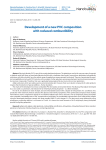
Development of a new PVC composition with reduced combustibility
Статья научная
Polyvinyl chloride (PVC) is one of the mostly plasticized polymers. The plasticizers used in this case are esters of aromatic or aliphatic acids with linear or branched aliphatic alcohols with a moderate chain length. Among them, phthalates (orthophthalic acid esters with fatty alcohols) have the widest range of applications among aromatic acid esters. They are characterized by excellent compatibility not only with PVC, but also with a number of other polymers, possess good physical and mechanical properties, but are toxic compounds. Therefore, their use is gradually being replaced by low-toxic and non-toxic plasticizers. Adipic acid esters which are widely used are environmentally safe. However, their use in plastic compounds for cable products requires the introduction of special additives – flame retardants. The results of the development of a low combustible PVC formulation are described herein. The dibutoxyethyl adipate developed by us was used as a plasticizer, and industrial di-(2-ethylhexyl) phenyl phosphate – as a flame retardant. First of all, we obtained an ester of adipic acid and ethoxylated butanol with a degree of ethoxylation of 5. Conditions of its production with maximum yield are selected. The physical and chemical properties of the synthesized compound were studied. Formulations of PVC compositions based on the obtained adipate with various amounts of di-(2-ethylhexyl) phenyl phosphate were compiled. Flammability tests of PVC compounds are presented. The combustible characteristics of the cable plastic samples using the developed plasticizers comply with state standard 5960-72 with changes 3-9. The best results were obtained by using phosphorus-containing additive in an amount of 3 wt%. It is shown that small amounts of di-(2-ethylhexyl) phenyl phosphate provide fire-fighting properties.
Бесплатно









